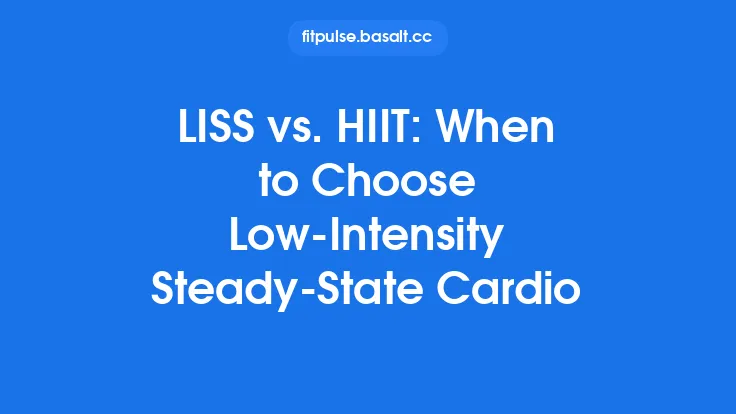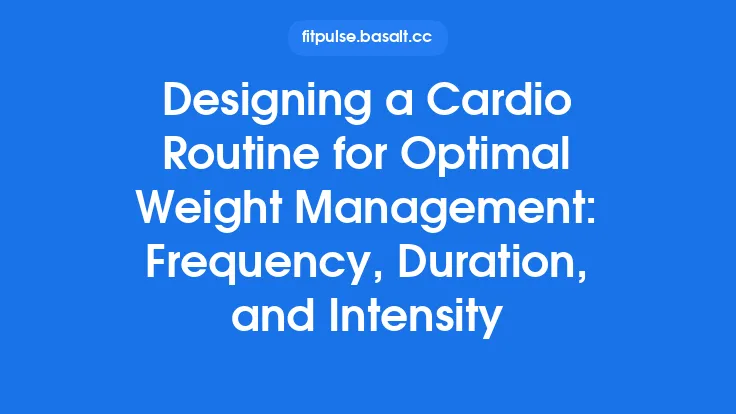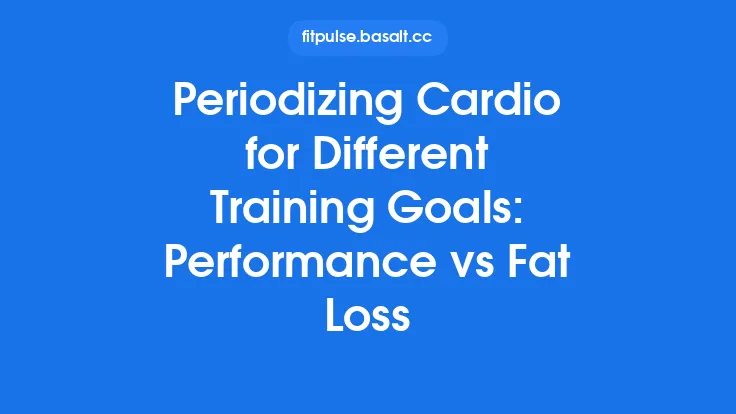Low‑Intensity Steady‑State (LISS) cardio is a powerful tool for anyone whose primary goal is to increase the proportion of calories burned from fat. While the “fat‑burning zone” is often oversimplified in popular media, a well‑structured weekly LISS plan can consistently push the body toward greater reliance on lipid oxidation, especially when the sessions are aligned with physiological rhythms, nutritional status, and recovery capacity. Below is a comprehensive guide to arranging those sessions for optimal fat oxidation, grounded in current metabolic understanding and practical training logistics.
Understanding Fat Oxidation and Its Relationship to LISS
Fat oxidation is a dynamic process governed by the balance between energy demand and substrate availability. During low‑intensity activity (≈40‑65 % of VO₂max), the relative contribution of fatty acids to total energy expenditure rises sharply because the aerobic system can meet the modest ATP demand without resorting to rapid glycolytic pathways. Key physiological factors that amplify this effect include:
| Factor | How It Influences Fat Oxidation |
|---|---|
| Muscle Glycogen Stores | Lower glycogen levels shift the muscle’s preference toward free fatty acids (FFAs) and intramuscular triglycerides. |
| Plasma Free Fatty Acid (FFA) Concentration | Elevated FFAs, often seen after an overnight fast or prolonged low‑intensity activity, increase the rate of fatty acid transport into mitochondria. |
| Hormonal Milieu | Higher circulating catecholamines (e.g., epinephrine) and lower insulin promote lipolysis, while elevated cortisol can augment FFA mobilization during prolonged sessions. |
| Mitochondrial Enzyme Activity | Repeated LISS exposure up‑regulates enzymes such as carnitine palmitoyl‑transferase I (CPT‑I), enhancing the capacity for fatty‑acid oxidation. |
Understanding these variables helps you manipulate training variables (timing, duration, intensity) to create an environment where the body preferentially burns fat.
Determining the Optimal Frequency of LISS Sessions
Frequency is the first lever to adjust when building a weekly schedule. The goal is to provide enough stimulus for metabolic adaptation without compromising recovery or interfering with other training priorities.
| Frequency | Typical Weekly Layout | Metabolic Rationale |
|---|---|---|
| 3 sessions/week | e.g., Mon‑Wed‑Fri or Tue‑Thu‑Sat | Sufficient to maintain elevated mitochondrial enzyme activity while allowing rest days for glycogen replenishment and muscle repair. |
| 4 sessions/week | e.g., Mon‑Tue‑Thu‑Fri | Increases total weekly caloric expenditure and can be useful for individuals with higher energy needs or those aiming for accelerated fat loss. |
| 5 sessions/week | e.g., Mon‑Tue‑Wed‑Fri‑Sat | Best reserved for highly trained individuals who can tolerate the cumulative volume and have robust recovery strategies (nutrition, sleep). |
For most recreational athletes and those primarily focused on fat loss, 3–4 sessions per week strike the best balance between stimulus and recovery.
Ideal Session Duration for Maximizing Fat Utilization
Duration directly influences the proportion of energy derived from fat. Short bouts (<20 min) rely heavily on carbohydrate oxidation, while longer bouts (>45 min) shift the substrate mix toward fat.
| Duration | Approximate Fat Contribution* |
|---|---|
| 20–30 min | 30‑40 % of total calories |
| 45‑60 min | 55‑65 % of total calories |
| >60 min | 70 %+ of total calories (plateaus after ~90 min) |
\*Values are averages from indirect calorimetry studies; individual variation exists.
Practical recommendation: Aim for 45‑60 minutes per session. This window provides a robust fat‑oxidation stimulus while keeping total weekly volume manageable. If time constraints exist, a 30‑minute session performed in a fasted state (see Nutrition section) can still yield meaningful fat utilization.
Heart Rate Zones and Energy Substrate Utilization
Heart rate (HR) is a convenient proxy for exercise intensity. For fat oxidation, the target zone typically aligns with 40‑65 % of maximal heart rate (HRmax) or 50‑70 % of VO₂max. To calculate HR zones:
- Estimate HRmax – 220 − age (or use a more individualized formula such as 208 − 0.7 × age).
- Determine the fat‑oxidation zone – Multiply HRmax by 0.40 and 0.65.
Example (30‑year‑old):
HRmax ≈ 190 bpm → Fat‑oxidation zone ≈ 76–124 bpm.
Why this range works: At these intensities, lactate production remains low, preserving the oxidative capacity of the mitochondria and allowing fatty acids to be the primary fuel. Exceeding ~70 % HRmax quickly shifts the balance toward carbohydrate metabolism.
Monitoring tip: Use a chest‑strap HR monitor for accuracy. If you lack a monitor, a simple method is to gauge perceived exertion (6‑12 on the Borg scale) while staying within the low‑moderate range, but avoid relying on the “talk test” as a primary metric to stay clear of overlapping content.
Timing LISS Sessions Within the Weekly Schedule
When you place LISS sessions relative to other training modalities (strength, sport‑specific work) can affect both fat oxidation and overall performance.
| Placement | Benefits for Fat Oxidation |
|---|---|
| Morning, fasted (≥8 h after last meal) | Low insulin levels promote lipolysis; glycogen stores are modest, encouraging reliance on FFAs. |
| Post‑strength training (2‑3 h after a resistance session) | Glycogen depletion from lifting creates a “fat‑oxidation window” during the subsequent LISS bout. |
| Separate day from high‑intensity work | Prevents competing catecholamine spikes that could blunt fat oxidation during LISS. |
| Evening, 1‑2 h after dinner | May be useful for individuals who cannot train in the morning; however, elevated insulin from recent meals can reduce fat utilization, so keep the meal low‑carb or allow a longer post‑prandial interval. |
Sample weekly layout (4 sessions):
| Day | Session | Timing |
|---|---|---|
| Monday | LISS – 45 min (fasted) | 07:00 |
| Tuesday | Strength training | |
| Wednesday | LISS – 60 min (post‑strength, 2 h after) | 18:00 |
| Thursday | Strength training | |
| Friday | LISS – 45 min (fasted) | 07:00 |
| Saturday | Optional active recovery or light LISS (30 min) | |
| Sunday | Rest |
This arrangement maximizes the metabolic environment for fat oxidation while preserving performance in strength sessions.
Nutritional Strategies to Enhance Fat Oxidation During LISS
Nutrition is the most potent modulator of substrate selection. Below are evidence‑based tactics that can be woven into a weekly LISS plan.
- Fast‑ed LISS (≥8 h post‑meal)
- Mechanism: Low insulin → increased hormone‑sensitive lipase activity → elevated plasma FFAs.
- Implementation: Train first thing after waking, or after an overnight fast. If you need a small pre‑workout snack, keep it ≤30 kcal and low‑carb (e.g., a few almonds).
- Low‑Carbohydrate Pre‑LISS Meal (if fasted training isn’t feasible)
- Guideline: ≤20 g of carbs, moderate protein, and healthy fats 60‑90 min before the session.
- Rationale: Keeps insulin modest while providing enough amino acids to protect muscle protein.
- Post‑LISS Re‑fueling
- Goal: Replenish glycogen for subsequent strength work without blunting the fat‑oxidation adaptations.
- Strategy: Consume a carbohydrate‑protein blend (≈1 g carbs per kg body weight) within 30 min after LISS if you have a strength session later that day. If LISS is the final workout, a modest protein intake (20‑30 g) suffices.
- Caffeine Timing
- Effect: Low‑dose caffeine (≈3 mg/kg) can increase lipolysis and spare glycogen.
- Use: Take 30 min before LISS, but avoid high doses that may raise HR beyond the fat‑oxidation zone.
- Hydration and Electrolytes
- Why: Dehydration can elevate heart rate, unintentionally pushing intensity out of the optimal zone.
- Tip: Aim for 500‑750 ml of water 2 h before training; add a pinch of sodium if you sweat heavily.
Managing Recovery and Adaptation Without Overtraining
Even though LISS is low‑intensity, cumulative volume can stress the cardiovascular system and affect recovery if not managed properly.
- Sleep: Prioritize 7‑9 hours per night. Sleep deprivation raises cortisol, which can impair lipid metabolism.
- Active Recovery Days: Light mobility or a short (15‑20 min) walk can promote circulation without adding metabolic load.
- Periodic Deload: Every 4‑6 weeks, reduce total LISS volume by 30‑40 % (e.g., drop from 4 to 2 sessions) to allow enzymatic adaptations to consolidate.
- Monitoring Non‑Exercise Activity Thermogenesis (NEAT): On high‑LISS weeks, keep daily step counts moderate to avoid excessive total energy expenditure that could trigger compensatory appetite increases.
Monitoring Progress and Adjusting the Weekly Plan
Quantifying the effectiveness of your LISS schedule helps you stay on track and make data‑driven tweaks.
| Metric | How to Track | Target/Interpretation |
|---|---|---|
| Body Fat Percentage | Skinfold calipers, bioelectrical impedance, or DEXA (every 4‑6 weeks) | Gradual decline of 0.5‑1 % per month is realistic. |
| Resting Heart Rate (RHR) | Morning measurement after waking | A decreasing trend (1‑3 bpm) can indicate improved aerobic efficiency. |
| Training Heart Rate Consistency | HR monitor logs | Sessions should stay within the prescribed zone >90 % of the time. |
| Subjective Energy Levels | Daily journal (rating 1‑10) | Stable or improving scores suggest adequate recovery. |
| Performance in Strength Sessions | Track load/reps | Maintaining or improving strength while doing LISS indicates no negative interference. |
If you notice plateaus in fat loss, consider:
- Increasing session duration by 5‑10 minutes (up to 75 min) on one day.
- Adding a fifth LISS session for a short (30 min) fasted walk.
- Re‑evaluating nutrition (e.g., tighter carbohydrate control before LISS).
Conversely, if fatigue or performance drops, reduce weekly volume or insert an extra rest day.
Common Pitfalls and How to Avoid Them
| Pitfall | Why It Undermines Fat Oxidation | Prevention |
|---|---|---|
| Training at Too High an Intensity | Shifts substrate use toward carbs, suppresses lipolysis. | Use HR zones; set alerts on your monitor to stay below the upper limit. |
| Consistently Exercising After Large Carb Meals | Elevated insulin blocks FFA release. | Schedule LISS at least 2 h after a moderate‑carb meal, or train fasted. |
| Neglecting Sleep or Stress Management | Cortisol spikes can increase appetite and blunt fat oxidation. | Implement consistent bedtime routines; incorporate stress‑reduction practices (e.g., breathing, meditation). |
| Over‑reliance on “Talk Test” | Subjective perception can be inaccurate, especially for trained individuals. | Rely on objective HR data rather than conversational ability. |
| Doing LISS Every Day Without Variation | May lead to adaptive plateau and reduced mitochondrial stimulus. | Cycle intensity slightly (e.g., one “steady‑state” day, one “low‑intensity interval” day) while staying within the fat‑oxidation zone. |
Putting It All Together: A Sample 8‑Week Blueprint
| Week | Sessions | Duration | Timing | Key Focus |
|---|---|---|---|---|
| 1‑2 | 3 × /week | 45 min | Fasted mornings | Establish baseline HR zone adherence. |
| 3‑4 | 4 × week | 45 min (3) + 60 min (1) | Add one post‑strength LISS | Increase total weekly fat‑oxidation volume. |
| 5‑6 | 4 × week | 60 min (2) + 45 min (2) | Alternate fasted & post‑strength | Boost mitochondrial stimulus. |
| 7‑8 | 3 × week (deload) | 30‑45 min | Fasted only | Allow adaptation, monitor RHR and body‑fat trends. |
After the 8‑week block, reassess body‑fat percentage, RHR, and strength metrics. Adjust the next macrocycle based on the data—either increase volume for continued loss or maintain the current schedule for weight‑maintenance while preserving metabolic health.
By thoughtfully arranging the frequency, duration, intensity, timing, and nutritional context of your LISS sessions, you create a weekly rhythm that consistently nudges the body toward greater reliance on fat as a fuel source. The result is not just a temporary boost in calorie burn, but a lasting enhancement of the metabolic pathways that support sustainable fat loss and overall cardiovascular health.





